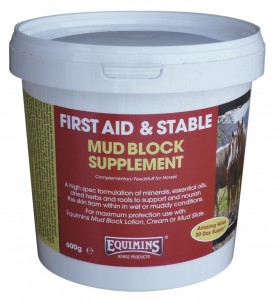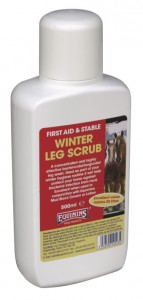Not so glorious mud
Whether you have a horse that’s plagued by mud fever or you just don’t like dealing with wet, muddy horses legs (who does?), the winter can be a really challenging time…but we do have some tips and products that might just help.
Let’s start off by looking at exactly what mud fever is. It’s caused by a bacteria in the mud that enters through damaged skin- this could be due to the skin being exposed to prolonged periods of wet or due to a cut or nick. Not all horses will get mud fever, it depends on a vast range of factors.
The symptoms can vary from a scab to swollen limbs and lameness. Most commonly, mud fever takes the form of scabs and sore skin. It can come in a small patch or be extensive but, in all situations, fast treatment is key- it can save your horse from suffering and reduce the length of time it takes for the sores to heal. It’s also important to realise that if the horse has severe mud fever, if it’s not responding to the treatment plan that you’re following or you’re concerned, calling the vet is a very good idea as in serious cases, veterinary treatment may be required.
Now, let’s look on the positive side of things, there are steps you can take that can help prevent mud fever. We know that it’s caused by a bacteria in the mud, and we know that horses with weak skin caused by prolonged periods of wet are more susceptible…so the first area to address is management style. If you can, fence off particularly wet areas and ensure that there are dry places in the field for him to stand…being up to his knees in mud during turnout time is not going to be good for many reasons!
If you’re concerned about mud fever or your horse is particularly susceptible, consider supplements that help to  improve skin condition from the inside out, like our Mud Block Supplement. This helps to nourish skin and keep it in the best condition, which is important when it comes to coping with winter. You can also look at topical applications like creams and lotions. These can be applied to the horse’s legs before turnout . Not only can these provide a physical barrier between the horse’s legs and the mud, but they can have other benefits too…for example…
improve skin condition from the inside out, like our Mud Block Supplement. This helps to nourish skin and keep it in the best condition, which is important when it comes to coping with winter. You can also look at topical applications like creams and lotions. These can be applied to the horse’s legs before turnout . Not only can these provide a physical barrier between the horse’s legs and the mud, but they can have other benefits too…for example…
Mud Block Cream contains cetrimide, a powerful bacteriostat to help protect from infection caused by bacteria in the mud.
Mud Block Lotion contains colloidal silver that has powerful properties when it comes to killing off bacteria. The lotion is ideal for horses with heavy feathering as it’s much easier to work into the leg hair.
Mud Slide Lotion contains pig oil to repel the mud, and antibacterial agent flowers of sulphur to help keep the bacteria at bay.
Another method of preventing the mud from coming into contact with the lower leg is to use turnout socks.
When the horse comes in from a day in the field, our products are designed to be washed off. This gives the  horse’s owner a great opportunity to check the legs and, if you use a product like Winter Leg Scrub, it gives you an extra line of protection as it’s antibacterial (and anti-fungal) too. Winter Leg Scrub doesn’t need washing off and should be applied with a sponge (when diluted).
horse’s owner a great opportunity to check the legs and, if you use a product like Winter Leg Scrub, it gives you an extra line of protection as it’s antibacterial (and anti-fungal) too. Winter Leg Scrub doesn’t need washing off and should be applied with a sponge (when diluted).
Prevention is always better than cure, but do be aware that should your horse get mud fever, he could need veterinary treatment.

 Equimins specialises in producing natural horse supplies, products and supplements for the major areas associated with caring for a horse. All products are proudly made in the UK and excellent specification quality products are of paramount importance. Using this blog we want to share some of the knowledge we have gained through nearly 30 years of experience.
Equimins specialises in producing natural horse supplies, products and supplements for the major areas associated with caring for a horse. All products are proudly made in the UK and excellent specification quality products are of paramount importance. Using this blog we want to share some of the knowledge we have gained through nearly 30 years of experience. 


